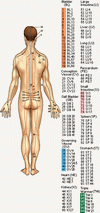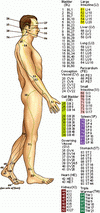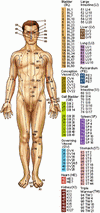How Acupressure Works
According to the tenets of TCM, chi is carried through our bodies along 14 channels, called meridians. The 14 meridians do not correspond to any visible anatomical structures in the body, such as nerves or blood vessels. But in Chinese medicine they are thought to embody a physical reality -- that of chi flowing through our bodies, providing nourishment and strength.Twelve of the meridians are bilateral; that is, identical versions of them exist on each side of the body. The other two run along the body's midline -- one along the front, the other along the back. Each of the 12 major meridians is named according to the anatomical structure, or organ, it is thought to influence. The meridians connect the interior and exterior of the body.
In acupressure, the flow of chi is strengthened, calmed or unblocked by pressing specific points along the meridians; the same points are used in the practice of acupuncture. Western scientists have shown that many of these points are located at key crossways of the autonomic nervous system. This may explain in part why they can affect pain that the patient experiences in a part of the body far from where the pressure is applied. A single point may be pressed for relief from a particular symptom or condition; or to promote overall well-being of the body, a series of points can be worked on in a specific order. Some well-controlled studies suggest that acupressure can be effective for a number of health problems, including pain, nausea and stroke-related weakness.
Applying Acupressure
Acupressure is the older, massage version of acupuncture. It is used mainly to reduce stress, but is also used to treat the conditions for which acupuncture is used, particularly in children. Shiatsu, a Japanese form of massage, is closely related to acupressure. While it focuses on massage of acupressure/acupuncture points, usually with deep finger pressure, shiatsu can also be delivered with the elbows, knees or feet.Acupressure is administered by someone specially trained in the technique or may be practiced at home by anyone who learns the location of the points, their corresponding symptoms or conditions, and how to apply the pressure. The force recommended for different points varies. In general, most points call for a steady, downward pressure lasting one to two minutes. If you plan to apply pressure to a specific point several times in a row, do so on one side of the body before switching to the corresponding point on other side. For any conditions other than minor muscle spasms or tension, it's best to see a trained professional for an evaluation and treatment.
If you're interested in learning about acupressure techniques to use at home, check for classes in your community. Some classes, such as Acu-Yoga classes, combine finger pressure with other techniques, including posture work, meditation and breathing exercises.
The risks of acupressure are minimal, provided certain cautions are observed. Pregnant women should never use the points designated Large Intestine 4 and Spleen 6 (see points 51 and 77 on the side-view illustration), nor any points in the abdominal area. Never apply pressure to open wounds, varicose veins, tumors, inflamed or infected skin, sites of recent surgery, or areas where a broken bone (see Fracture) is suspected.



